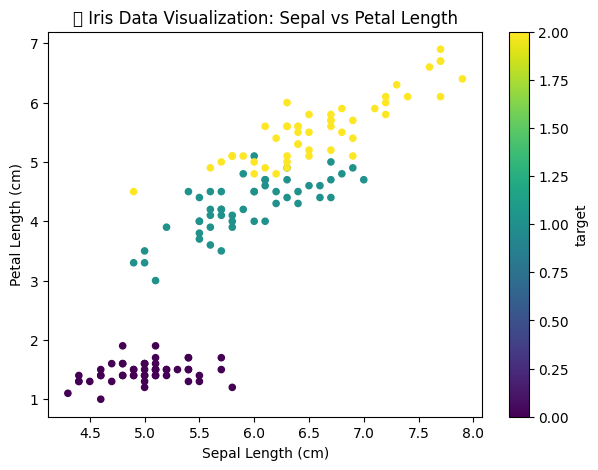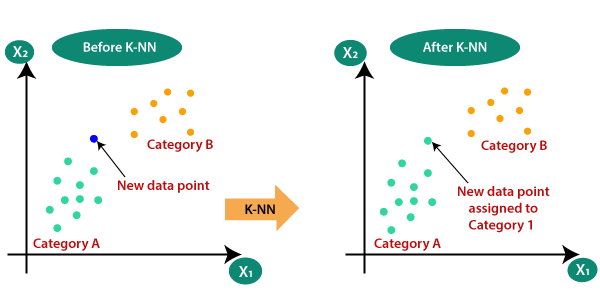Section 5. Your First Algorithm: k-Nearest Neighbors (KNN)#
To kick off your journey, we’ll start with the k-Nearest Neighbors (KNN) algorithm. It’s often called a “lazy learner” because it doesn’t really “train” a model in the traditional sense; it just memorizes the training data.
Steps of standard KNN Algorithm:#
Step-1: Select the number K of the neighbors
Step-2: Calculate the Euclidean distance of K number of neighbors
Step-3: Take the K nearest neighbors as per the calculated Euclidean distance.
Step-4: Among these k neighbors, count the number of the data points in each category.
Step-5: Assign the new data points to that category for which the number of the neighbor is maximum.
Step-6: Our model is ready.

Key takeaway: KNN is simple, powerful, and easy to interpret, but choosing the right \(k\) and calculating all those distances can make it slow with very large datasets.
Next Steps:#
In the code cell below, we will perform the full 5-step workflow using a simple Classification algorithm to predict the species of a flower based on its measurements!
# --- STEP 1: Import Libraries and Load Data ---
print("--- STEP 1: Loading Data ---")
import pandas as pd
from sklearn.datasets import load_iris
from sklearn.model_selection import train_test_split
from sklearn.tree import DecisionTreeClassifier
from sklearn.neighbors import KNeighborsClassifier
from sklearn.metrics import accuracy_score
import matplotlib.pyplot as plt
# Load the famous Iris flower dataset (built-in classification dataset)
iris = load_iris(as_frame=True) # Load as DataFrame for clarity
data = iris.frame # includes both features and target columns
# Display the first few rows to understand the data
print("First 5 data samples:")
print(data.head())
print("-" * 40)
--- STEP 1: Loading Data ---
First 5 data samples:
sepal length (cm) sepal width (cm) petal length (cm) petal width (cm) \
0 5.1 3.5 1.4 0.2
1 4.9 3.0 1.4 0.2
2 4.7 3.2 1.3 0.2
3 4.6 3.1 1.5 0.2
4 5.0 3.6 1.4 0.2
target
0 0
1 0
2 0
3 0
4 0
----------------------------------------
# --- Optional Visualization: Exploring the Iris Data ---
# Load dataset
iris = load_iris()
df = pd.DataFrame(iris.data, columns=iris.feature_names)
df['target'] = iris.target
# Scatter plot colored by target (species)
df.plot(kind='scatter',
x='sepal length (cm)',
y='petal length (cm)',
c='target',
colormap='viridis',
figsize=(7, 5))
plt.title('🌸 Iris Data Visualization: Sepal vs Petal Length')
plt.xlabel('Sepal Length (cm)')
plt.ylabel('Petal Length (cm)')
plt.show()
/opt/hostedtoolcache/Python/3.11.13/x64/lib/python3.11/site-packages/IPython/core/pylabtools.py:170: UserWarning: Glyph 127800 (\N{CHERRY BLOSSOM}) missing from font(s) DejaVu Sans.
fig.canvas.print_figure(bytes_io, **kw)

# --- STEP 2: Define Features (X) and Label (y) ---
# X (Features): The measurements used for prediction
X = data.drop(columns=['target'])
# y (Label): The thing we want to predict (flower species, coded 0, 1, or 2)
y = data['target']
print(f"Features (X) shape: {X.shape}")
print(f"Label (y) shape: {y.shape}")
print("-" * 40)
# --- STEP 3: Split Data for Training and Testing ---
X_train, X_test, y_train, y_test = train_test_split(
X, y, test_size=0.3, random_state=42
)
print(f"Training Samples (for E - Experience): {len(X_train)}")
print(f"Testing Samples (for P - Performance check): {len(X_test)}")
print("-" * 40)
# --- STEP 4: Train the Model (The Learning Step) ---
# 1. Choose the Model (Algorithm)
model = KNeighborsClassifier(n_neighbors=3) # Using 3 nearest neighbors
# 2. Train the Model (learn from training data)
print("Training the K-Nearest Neighbors model on the Training Set...")
model.fit(X_train, y_train)
print("Training complete! Model has learned patterns.")
print("-" * 40)
# --- STEP 5: Make Predictions and Evaluate ---
y_pred = model.predict(X_test)
knn_accuracy = accuracy_score(y_test, y_pred)
print(f"First 5 Actual Labels (y_test): {y_test.values[:5]}")
print(f"First 5 Model Predictions (y_pred): {y_pred[:5]}")
print("-" * 40)
print(f"Overall Model Accuracy on Test Data (Performance P): {knn_accuracy:.2f}")
# A result close to 1.00 (or 100%) indicates a highly successful model!
Features (X) shape: (150, 4)
Label (y) shape: (150,)
----------------------------------------
Training Samples (for E - Experience): 105
Testing Samples (for P - Performance check): 45
----------------------------------------
Training the K-Nearest Neighbors model on the Training Set...
Training complete! Model has learned patterns.
----------------------------------------
First 5 Actual Labels (y_test): [1 0 2 1 1]
First 5 Model Predictions (y_pred): [1 0 2 1 1]
----------------------------------------
Overall Model Accuracy on Test Data (Performance P): 1.00
# --- BONUS: Train, Predict, and Evaluate Decision Tree (for comparison) ---
# 1. Initialize the Decision Tree Model
dt_model = DecisionTreeClassifier(random_state=42)
# 2. Train the Model (This involves learning complex rules)
print("Training Decision Tree Model...")
dt_model.fit(X_train, y_train)
# 3. Make Predictions and Evaluate
dt_y_pred = dt_model.predict(X_test)
dt_accuracy = accuracy_score(y_test, dt_y_pred)
print(f"Decision Tree Model Accuracy: {dt_accuracy:.2f}")
print("-" * 40)
# --- Final Comparison ---
print("Model Comparison:")
print(f"KNN (k=5) Performance: {knn_accuracy:.2f}")
print(f"Decision Tree Performance: {dt_accuracy:.2f}")
# The results show which model performed better on this specific task!
Training Decision Tree Model...
Decision Tree Model Accuracy: 1.00
----------------------------------------
Model Comparison:
KNN (k=5) Performance: 1.00
Decision Tree Performance: 1.00
